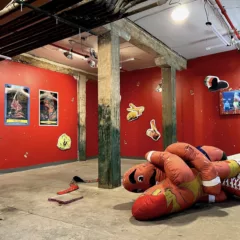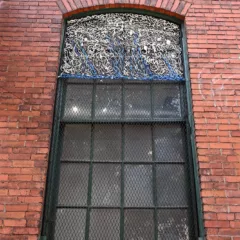Curators Timothy Belknap and Ryan McCartney harness the meta-ness of our zeitgeist by constructing a physical gallery within the massive confines of the Icebox project space at the Crane Arts Building. The exhibition, “Winter Down,” includes work by five artists – Amy Lincoln, Beth Livensperger, Mike Stifel, Becky Suss, and Douglas Witmer – all displayed in the skewed, pentagonal gallery-within-a-gallery constructed specifically for this show.
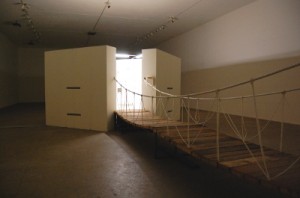
Upon stepping into the Icebox at Crane, the first thing to confront the viewer is a white-walled, open-topped structure smack dab in the center of the room. Leading up to the fifth (missing) side is a hanging, wooden bridge which ushers visitors into the brightly lit interior.
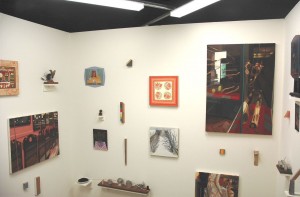
For “Winter Down,” the role of curator has been blurred beyond its traditional role into the realm of creator. Surely the cubicle-like area full of art and the creaking span leading inside are artworks in and of themselves. The curators of this show become part of the exhibit as creators almost as much as the artists they showcase.
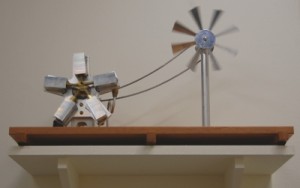
After crossing the bridge, the bright, white walls inside the tiny room bristle with art objects: paintings, wooden forms and metallic machines. It all comes together to seem part gallery, part eccentric grandparents’ living room, and part laboratory. The latter is perhaps most obvious when Mike Stifel’s pneumatic machine comes to life, breaking the silence and stillness of the otherwise static show. Every five minutes or so, one of the functioning contraptions, “Windmills do not work that way,” hisses with air and begins to spin. While it resembles one of the gigantic energy-producing devices, it actually works in reverse of its larger cousins and produces only movement from pressurized air instead of harnessing power from natural wind. Alternative energy isn’t Stifel’s only foray into contemporary political hot spots, as one of his other machines is titled after the infamous “Patriot Act.” Otherwise his pieces seem straight out of the steel mill – sterile components that are as shiny and splendidly functionless as brand new rims on a cheap car.
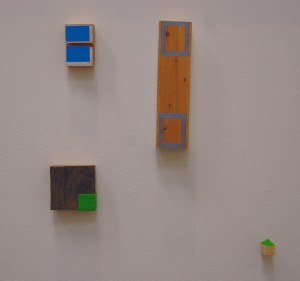
Douglas Witmer counters Stifel’s steel with tiny wooden fixtures that seem as much a part of the structure as part of the show, further obfuscating the lines between organization and creation. The Witmer pieces jut out here and there between the other paintings adding accents, handle-like extensions, and sections of solid-colored paint in a sort of Hooverville-Baroque style which is more than appropriate for the domicile-like gallery.
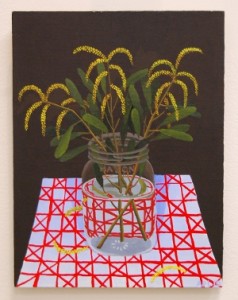
To add to the domestic feel of Stifel’s almost-appliances and Witmer’s minimal interior decorating, Amy Lincoln provides the flowers and houseplants. No cozy home is complete without a few photosynthetic friends, and her mostly realistic renderings of stems and petals provide a little sprig of life within the mostly object-based exhibit. Besides, the insular space of “Winter Down” seems ideal to hunker down against the harsh cold of January. What better than blossoms and green leaves to remind us of the approaching relief of spring?
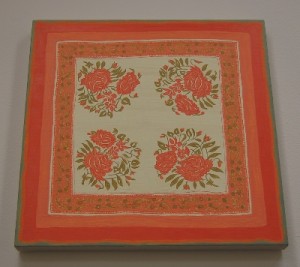
Becky Suss provides both plush, painted pillows and window-like views of the outside world, helping to delineate the borders between interior and exterior. The warm colors and patterns of her pillows provide contrast to the snowy trees and tombstones of her landscapes. The cushions seem to have been imported from distant, tropical lands and serve to placate visitors (or tenants) as much as the brisk scenes of the outside chill and remind us of what is beyond the walls.
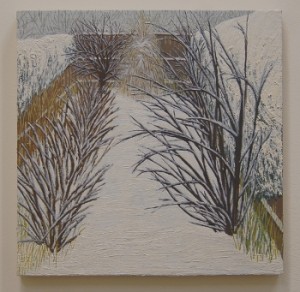
Beth Livensperger is one of the hardest artists here to fit into a niche, but her expressive scenes help to add a background of clutter and lived in/worked in locations that inundate the rest of the work. Gas tanks, rows of wood-framed mirrors, and stacks of books provide just a bit of disorganization and activity to the overall sensation of spending time inside the Icebox’s strange squatter. Livensperger’s hand provides dreamy reflections, adding a sense of distance and nostalgia into the mix, while her painting “Guns II” presents antique firearms behind glass in a museum setting, perhaps reminding us that ultimately this is still just a show.
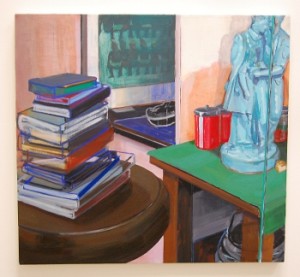
The coldest of months may be upon us, but “Winter Down” reminds us that we need only go inside – figuratively or literally – to find refuge from the elements. The precision and care with which this exhibit is assembled provides a unique treat, and the show stands as a monumental testament to the New Year and all its potential. Whether a comfy home environment, a busy workshop, or a self-contained temporary art gallery, the structure and contents of “Winter Down” surround us with a rigorous conceptual display that fits somewhere between tightly built shelter and free-form art foray. It will stand inside Crane Arts through February 9, with a closing reception on Saturday February 2, from 3:00 – 6:00.





